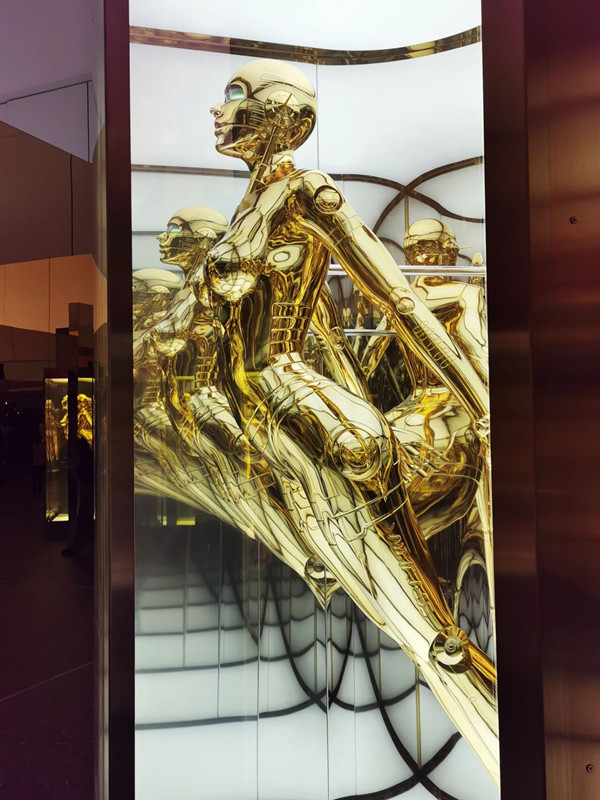
Hajime Sorayama’s shiny “Sexy Robot” artworks on display at the “Light, Reflection, Transparency” exhibition at the MOCAUP. Photos by Cao Zhen unless otherwise stated
Hajime Sorayama’s metallic “Sexy Robot” sculptures are familiar to many art lovers, but seeing an exhibition featuring many of these shiny, sensual femme-bots — each in a distinct pose — is a different experience. The effect is amplified in a mirrored room, where gleaming bodies multiply into infinity and create an utterly breathtaking spectacle.
Now visitors in Shenzhen can see these awe-inspiring works at “Light, Reflection, Transparency” at the Shenzhen Museum of Contemporary Art and Urban Planning (MOCAUP). The retrospective, presented in collaboration with Nanzuka Art Institute, also includes paintings, videos, installations, and fashion pieces, and surveys Sorayama’s most significant works from the late 1970s to the present.

A glance at the exhibition.

The “Infinity Space Traveler” section at the exhibition.
Across 10 sections, the exhibition traces the artist’s signature fusion of human sensuality and machinery — from early paintings of the 1970s to the influential sculptures that have shaped the visual language of sci‑fi and left a mark on art, design and commerce. It also highlights his collaborations with fashion brands and musicians that have drawn international attention.
Whether it’s the aluminum Mickey sculpture, the polished “Space Traveler” installation, or the floating “Sexy Robot” pieces, the works’ mirrored surfaces reveal meticulous craftsmanship and offer a mesmerizing vision of futuristic beauty.

Hajime Sorayama’s “Future Mickey II” (2021).

A glance at the exhibition.
In the “Mirror Maze” room, several “Sexy Robot” sculptures are displayed in transparent cabinets. Their polished surfaces produce liquid‑sharp reflections; mirrors in the space turn a single figure into an endless, futuristic legion. Some sculptures appear to float in an illusion of boundless space, as if the slim, elegant robots might burst free from the cabinets at any moment.
Two other striking rooms are “The Thesmophoria” and “Gallery,” where “Sexy Robot” sculptures stand among acrylics and digitally printed canvases. Here, Sorayama reimagines iconic images — Botticelli’s “Birth of Venus,” Marilyn Monroe and others — with metallic skin, blending classical motifs with futuristic aesthetics and collapsing any sense of temporal limits.


Gleaming metallic bodies multiply into infinity in the “Mirror Maze” room.
“Maybe you can imagine that if you paint a metallic body or something like that, how you can present the metallic object in the paintings with only a few basic colors. You can’t use real gold or real silver,” Shinji Nanzuka, founder of Nanzuka Art Institute and curator of the Shenzhen exhibition, told Shenzhen Daily in an exclusive interview.
“So it’s important that you have to present it through light and transparency. Transparency means air. Reflection is the key… How to manipulate perception so the viewer reads it as a chrome body or metal in the painting,” he added.

Hajime Sorayama’s “Untitled” (1982), acrylic on illustration board. Photo by Lin Songtao

Hajime Sorayama’s “Untitled” (2024), acrylic, digital print on canvas. Photo by Lin Songtao
The exhibition title “Light, Reflection, Transparency,” captures the essence of Sorayama's artistic pursuit: using paint to render light — a challenge that requires mastering the representation of air, transparency and reflection. This meticulous approach highlights the interplay of art and technology and cements his unique place in contemporary visual arts.
“Sorayama has been obsessed with aesthetics since he was a kid,” Nanzuka said. “He told this experience about going to a metal factory and he saw cutting metal produced strong, shining reflections. He absorbed that sight as a visual language; this is beautiful.”

Hajime Sorayama’s “Untitled” (2022), acrylic, digital print on canvas.
Other works on display document Sorayama’s ongoing experiments with painting light and transparency. The “Pink Room” presents rarely seen early pieces, including his first robot painting from 1978, Aerosmith’s “Just Push Play” album cover in 2001, collaborations involving Mickey and Kamen Rider, and original sketches for Sony’s robotic dog Aibo in 1999. Together, these works chronicle how Sorayama not only defined a visual archetype for robots but also inspired creations across film, fashion and design.
The curator believes that Shenzhen’s role as a high‑tech hub makes it an ideal setting for Sorayama’s work. With a broad collection and a 12‑meter‑tall “Sexy Robot” displayed outside the museum, the exhibition delivers a striking experience and encourages public engagement with contemporary art.

A visitor takes photos at the exhibition. Photo by Lin Songtao

Hajime Sorayama’s “Untitled” (1999), acrylic on illustration board. Photo by Lin Songtao
Dates: Through Jan. 11, 2026
Hours: 10 a.m.-6 p.m., closed Mondays
Tickets: 88 yuan per person (various discounts available)
Venue: Shenzhen Museum of Contemporary Art and Urban Planning, Futian District (深圳市当代艺术与城市规划馆)
Metro: Line 3 or 4 to Children’s Palace Station (少年宫站), Exit A2